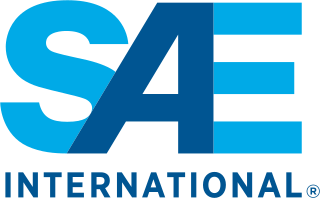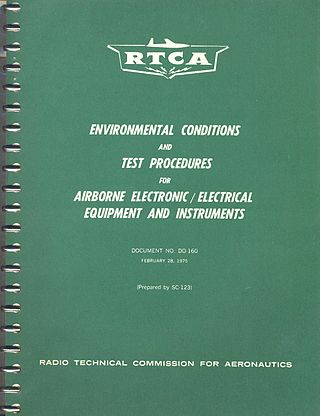DO-178B, Software Considerations in Airborne Systems and Equipment Certification is a guideline dealing with the safety of safety-critical software used in certain airborne systems. It was jointly developed by the safety-critical working group RTCA SC-167 of the Radio Technical Commission for Aeronautics (RTCA) and WG-12 of the European Organisation for Civil Aviation Equipment (EUROCAE). RTCA published the document as RTCA/DO-178B, while EUROCAE published the document as ED-12B. Although technically a guideline, it was a de facto standard for developing avionics software systems until it was replaced in 2012 by DO-178C.
A hazard analysis is used as the first step in a process used to assess risk. The result of a hazard analysis is the identification of different types of hazards. A hazard is a potential condition and exists or not. It may, in single existence or in combination with other hazards and conditions, become an actual Functional Failure or Accident (Mishap). The way this exactly happens in one particular sequence is called a scenario. This scenario has a probability of occurrence. Often a system has many potential failure scenarios. It also is assigned a classification, based on the worst case severity of the end condition. Risk is the combination of probability and severity. Preliminary risk levels can be provided in the hazard analysis. The validation, more precise prediction (verification) and acceptance of risk is determined in the risk assessment (analysis). The main goal of both is to provide the best selection of means of controlling or eliminating the risk. The term is used in several engineering specialties, including avionics, food safety, occupational safety and health, process safety, reliability engineering.

ARP4754, Aerospace Recommended Practice (ARP) ARP4754B, is a guideline from SAE International, dealing with the development processes which support certification of Aircraft systems, addressing "the complete aircraft development cycle, from systems requirements through systems verification." Revision A was released in December 2010. It was recognized by the FAA in AC 20-174 published November 2011. EUROCAE jointly issues the document as ED–79.
RTCA DO-254 / EUROCAE ED-80, Design Assurance Guidance for Airborne Electronic Hardware is a document providing guidance for the development of airborne electronic hardware, published by RTCA, Incorporated and EUROCAE. The DO-254/ED-80 standard was formally recognized by the FAA in 2005 via AC 20-152 as a means of compliance for the design assurance of electronic hardware in airborne systems. The guidance in this document is applicable, but not limited, to such electronic hardware items as
Integrated modular avionics (IMA) are real-time computer network airborne systems. This network consists of a number of computing modules capable of supporting numerous applications of differing criticality levels.

DO-160, Environmental Conditions and Test Procedures for Airborne Equipment is a standard for the environmental testing of avionics hardware. It is published by the Radio Technical Commission for Aeronautics (RTCA) and supersedes DO-138.
Functional safety is the part of the overall safety of a system or piece of equipment that depends on automatic protection operating correctly in response to its inputs or failure in a predictable manner (fail-safe). The automatic protection system should be designed to properly handle likely systematic errors, hardware failures and operational/environmental stress.
DO-178C, Software Considerations in Airborne Systems and Equipment Certification is the primary document by which the certification authorities such as FAA, EASA and Transport Canada approve all commercial software-based aerospace systems. The document is published by RTCA, Incorporated, in a joint effort with EUROC and replaces DO-178B. The new document is called DO-178C/ED-12C and was completed in November 2011 and approved by the RTCA in December 2011. It became available for sale and use in January 2012.
Advisory circular (AC) refers to a type of publication offered by the Federal Aviation Administration (FAA) to provide guidance for compliance with airworthiness regulations, pilot certification, operational standards, training standards, and any other rules within the 14 CFR Aeronautics and Space Title. They define acceptable means, but not the only means, of accomplishing or showing compliance with airworthiness regulations. Generally informative in nature, Advisory Circulars are neither binding nor regulatory; yet some have the effect of de facto standards or regulations.

AC 25.1309–1 is an FAA Advisory Circular (AC) that identifies acceptable means for showing compliance with the airworthiness requirements of § 25.1309 of the Federal Aviation Regulations. Revision A was released in 1988. In 2002, work was done on Revision B, but it was not formally released; the result is the Rulemaking Advisory Committee-recommended revision B-Arsenal Draft (2002). The Arsenal Draft is "considered to exist as a relatively mature draft". The FAA and EASA have subsequently accepted proposals by type certificate applicants to use the Arsenal Draft on development programs.

The Advisory Circular AC 20-115( ), Airborne Software Development Assurance Using EUROCAE ED-12( ) and RTCA DO-178( ), identifies the RTCA published standard DO-178 as defining a suitable means for demonstrating compliance for the use of software within aircraft systems. The present revision D of the circular identifies ED-12/DO-178 Revision C as the active revision of that standard and particularly acknowledges the synchronization of ED-12 and DO-178 at that revision.

The Advisory Circular AC 20-152A, Development Assurance for Airborne Electronic Hardware, identifies the RTCA-published standard DO-254 as defining "an acceptable means, but not the only means" to secure FAA approval of complex custom micro-coded components within aircraft systems with Item Design Assurance Levels (IDAL) of A, B, or C. Specifically excluding COTS microcontrollers, complex custom micro-coded components include field programmable gate arrays (FPGA), programmable logic devices (PLD), and application-specific integrated circuits (ASIC), particularly in cases where correctness and safety can not be verified with testing alone, necessitating methodical design assurance.
DO-248C, Supporting Information for DO-178C and DO-278A, published by RTCA, Incorporated, is a collection of Frequently Asked Questions and Discussion Papers addressing applications of DO-178C and DO-278A in the safety assurance of software for aircraft and software for CNS/ATM systems, respectively. Like DO-178C and DO-278A, it is a joint RTCA undertaking with EUROCAE and the document is also published as ED-94C, Supporting Information for ED-12C and ED-109A. The publication does not provide any guidance additional to DO-178C or DO-278A; rather, it only provides clarification for the guidance established in those standards. The present revision is also expanded to include the "Rationale for DO-178C/DO-278A" section to document items that were considered when developing DO-178B and then DO-178C, DO-278A, and DO-330, as well as the supplements that accompany those publications.
CAST-32A, Multi-core Processors is a position paper, by the Certification Authorities Software Team (CAST). It is not official guidance, but is considered informational by certification authorities such as the FAA and EASA. A key point is that Multi-core processor "interference can affect execution timing behavior, including worst case execution time (WCET)."
DO-297, Integrated Modular Avionics (IMA) Development Guidance and Certification Considerations is one of the primary document by which certification authorities such as the FAA and EASA approve Integrated Modular Avionics (IMA) systems for flight. The FAA Advisory Circular (AC) 20-170 refers to DO-297.
The Advisory Circular AC 00-69, Best Practices for Airborne Software Development Assurance Using EUROCAE ED-12( ) and RTCA DO-178( ), initially issued in 2017, supports application of the active revisions of ED-12C/DO-178C and AC 20-115. The AC does not state FAA guidance, but rather provides information in the form of "best practices" complementary to the objectives of ED-12C/DO-178C.

CAST-31, Technical Clarifications Identified for RTCA DO-254 / EUROCAE ED-80 is a Certification Authorities Software Team (CAST) Position Paper. It is an FAA publication that "does not constitute official policy or guidance from any of the authorities", but is provided for educational and informational purposes only for applicants for software and hardware certification.
The Certification Authorities Software Team (CAST) is an international group of aviation certification and regulatory authority representatives. The organization of has been a means of coordination among representatives from certification authorities in North and South America, Europe, and Asia, in particular, the FAA and EASA. The focus of the organization has been harmonization of Certification Authorities activities in part though clarification and improvement of the guidance provided by DO-178 and DO-254.

CAST-15, Merging High-Level and Low-Level Requirements is a Certification Authorities Software Team (CAST) Position Paper. It is an FAA publication that "does not constitute official policy or guidance from any of the authorities", but is provided to applicants for software and hardware certification for educational and informational purposes only.

FAA Order 8110.37 , Designated Engineering Representative (DER) Handbook, is a handbook of procedures, technical guidelines, limitations of authority, tools, and resources for Designated Engineering Representatives (DERs), who are appointees of the Federal Aviation Administration. Both DERs and the FAA offices managing them have individual and mutual roles and responsibilities in the certifications of safety of aircraft and aviation systems. This handbook provides a better understanding of these roles. Although intended for the roles of DERs, this order may be useful to ODA engineering Unit Members, who are effectively DERs managed by aviation manufacturers rather than by the FAA.



